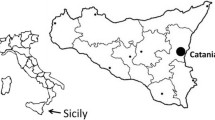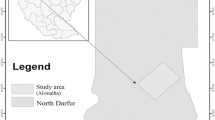Abstract
The vectors of Leishmania major were investigated in Marigat, Baringo District, Kenya, a focus of both visceral and dermal leishmaniases. These studies resulted in the discovery of the resting sites of Phlebotomus duboseqi, a known vector of L. major, and of alternate principal resting sites of Phlebotomus martini, a known vector of visceral leishmaniasis. Furthermore, Sergentomyia ingrami was incriminated as a possible vector of L. major among susceptible rodents inside burrows. Trapping methods which have resulted in the discovery of the resting sites of these phlebotomine sandflies are presented in this paper.
Résumé
Des études sur les vecteurs de Leishmania major ont été conduitgà Marigat District de Baringo foyer de leishmanioses de type visceral et dermique. Le résultat de ces études a été la découverte des sites de repos du Phlebotomes duboseqi, un vecteur bien connu de L. major. D’autres sites de repos de Phlebotomus martini, un vecteur connu de leishmaniose viscéral, ont été aussi découverts. En outre ont a trouvé qu’une espèce appartenant à la famille de Sergentomyia, S. ingrami était un vecteur possible de L. major parmi les rongeurs susceptibles à l’intérieur de leurs terriers. L’impact de ces découvertes est discuté, et les méthodes de piéger ces insectes qui ont conduit á la découverte de leurs sites de repos sont présentées et comparées.
Similar content being viewed by others
References
Abonnenc E. and Lariviere M. (1959) Repartition des phlebotomes des l’Ouest Africain (Diptera-Psychodidae). Bull. Inst. fr. Afr. noire 21, 204–226.
Abonnenc E. and Pastre J. (1971) Phlebotomes de la haute Volta (Diptera, Psychodidae). Notes biologiques. Cah. ORSTOM Sér. int. med. Parasit 9, 389–416.
Beach R., Young D. G. and Mutinga M. J. (1983) Phlebotomus duboscqi from Kenya. A new record. Trans. R. Soc. trop. Med. Hyg. 67, 707–708.
Chance M. L., Schnur L. F., Thomas S. C. and Peters W. (1978) The biochemical and serological taxonomy of Leishmania from Aethiopian zoogeographical region of Africa. Ann. trop. Med. Parasit. 72, 533–542.
Dedet J. P., Derouin F. and Cornet M. (1978) Infestation spontanée de Phlebotomus duboscqi par des promastigotes de leishmania au Senegal. C.r. Acad. Sci., Paris series D 286, 301–302.
Dedet J. P., Derouin F., Hubert B., Schnur L. F. and Chance M. C. (1979) Isolation of Leishmania major from Mastomys erythroleucus and Tatera gambiana in Senegal. Ann. trop. Med. Parasit. 72, 433–437.
Dedet J. P., Derouin F. and Hubert B. (1980) Ecologie d’un foyer de leishmaniose cutanée dans la régions de Thies (Senegal, Afrique de l’ouest). 4. Infestation spontanée et biologie de Phlebotomus duboscqi Neveu-Lamaire, 1906. Bull. Soc. Path. exot. 73, 266–276.
Dedet J. P., Hubert B., Deajeux P. and Derouin F. (1982) Ecology of a focus of cutaneous leishmaniasis in Thies region (Senegal, West Africa). 5. Spontaneous infestation and role of various species of wild rodents as reservoirs. Bull. Soc. Path exot. 75, 599–606.
Heisch R. B. (1963) Is there an animal reservoir of kala-azar in Kenya? E. Afr. med. J. 40, 360–362.
Lariviere M. (1966) Aspects cliniques et épidémiologiques de la leishmanoise cutanée au Senegal. Bull. Soc. Path, exot. 59, 83–98.
Lariviere M., Abonnenc E. and Kramer R. (1961) Chronique de la Leishmaniose cutanée en Afrique Occidentale. Problem du vecteur. Bull Soc. Path. exot. 54, 1031–1046.
Lariviere M., Camerlynck P., Ranque P., Vollod M. T., Diagne S., Rayboud N. and Toury M. F. (1965) A la recherche d’un reservoir de virus animal de la leishmaniose cutanee de l’homme au Senegal: Presence de Leishmania chez Arvicanthis sp. Bull. Soc. med. Afr. Noire Lang. Lr. 10, 237–238.
Mutinga M. J. (1981) An efficient trap for sandflies (Diptera: Phlebotomidae). Insect Sci. Applic. 1, 203–206.
Mutinga M. J. and Odhiambo T. R. (1982) Studies on infection rates of human baited anthropophilic sandflies in Machakos District, Kenya. Insect Sci. Applic. 3, 311–314.
Mutinga M. J. and Kaddu J. B. (1983) Studies on vectors of Leishmania major in Kenya. Proceedings of the 58th Annual Meeting of the American Society of Parasitologists, San Antonio, Texas U.S.A. December 1983, p. 57.
Mutinga M. J. and Ngoka J. M. (1983) Investigations of animal reservoirs of visceral leishmaniasis and the isolation of Leishmania major in Marigat, Baringo District, Kenya. Insect Sci. Applic. 4, 237–240.
Mutinga M. J., Kaddu J. B. and Irungu L. W. (1981) Animal models for feeding Kenyan wild caught Phlebotomine sandflies (Diptera: Phlebotomidae). Insect Sci. Applic. 2, 149–152.
Parrot L. M. and Gougis R. (1943) Sur l’agent probable de transmission du bouton d’orient dans la colonie du Niger. Arch. Inst. Pasteur Alger. 21, 268–269.
Ranque Ph. and Camerlynck P. (1966) Demonstration du pouvoir pathogene pour l’homme de la souche de Leishmania isotée chéz un Arvicanthis niloticus a piroundary (Senegal). Innoculation voluntaire, auto-observation. C.r. Acad. Sci., Paris. 262, 664–665.
Regeau J. (1951) Phlebotomes du Cameroun. Bull. Soc. Path. exot. 44, 793–800.
Rouband E. (1913) Quelques notes sur les Phlebotomes de l’Afrique occidentale Française. Bull. Soc. Path. exot. 6, 126–128.
Southgate B. A. and Minter D. M. (1967) Leishmaniasis and its control in Kenya; the present situation. WHO InterRegional Travelling Seminar on Leishmaniasis, U.S.S.R. 22nd May-10th June 1967, pp. 1–36.
Author information
Authors and Affiliations
Rights and permissions
About this article
Cite this article
Mutinga, M.J., Kyai, F.M. & Omogo, D.M. Investigations on the Epidemiology of Leishmaniases in Kenya—I. Int J Trop Insect Sci 7, 181–189 (1986). https://doi.org/10.1017/S1742758400008948
Received:
Revised:
Published:
Issue Date:
DOI: https://doi.org/10.1017/S1742758400008948




